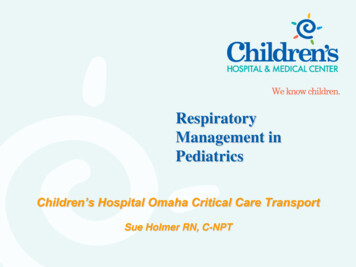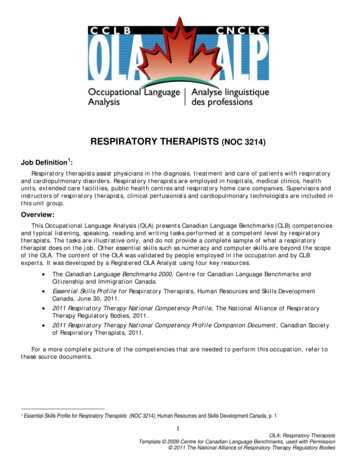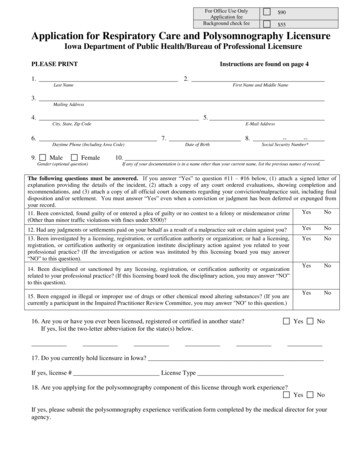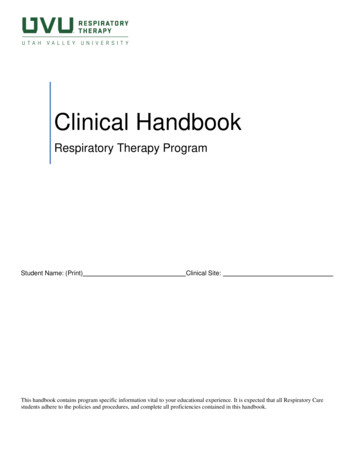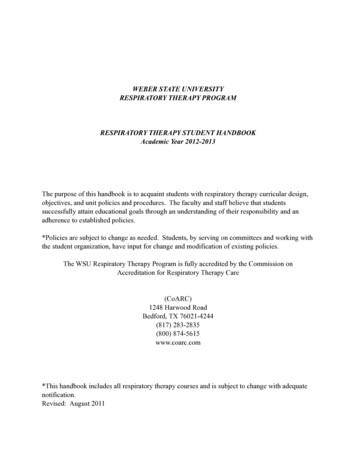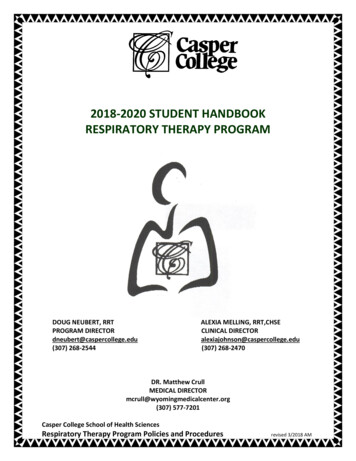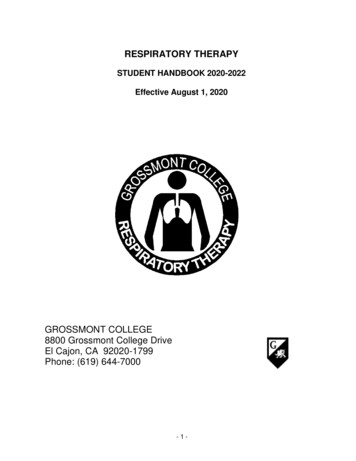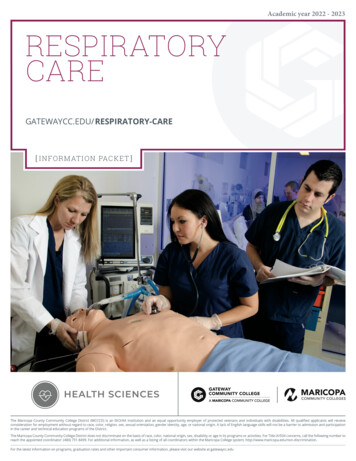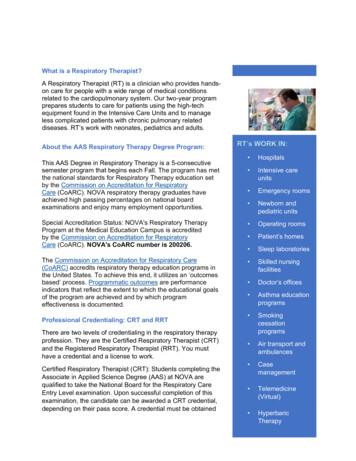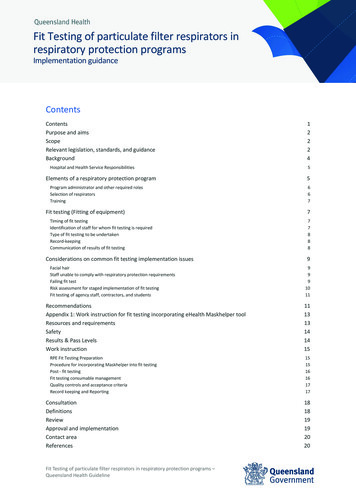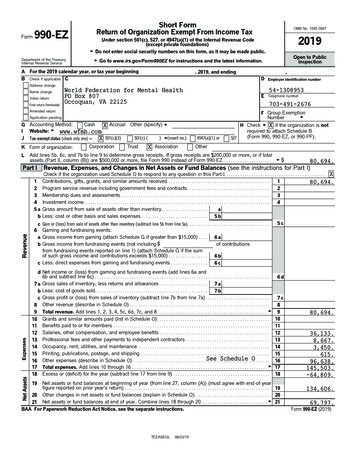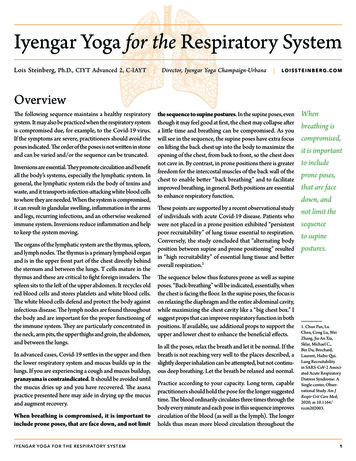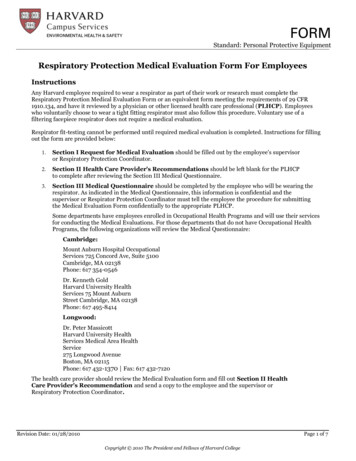
Transcription
FORMStandard: Personal Protective EquipmentRespiratory Protection Medical Evaluation Form For EmployeesInstructionsAny Harvard employee required to wear a respirator as part of their work or research must complete theRespiratory Protection Medical Evaluation Form or an equivalent form meeting the requirements of 29 CFR1910.134, and have it reviewed by a physician or other licensed health care professional (PLHCP). Employeeswho voluntarily choose to wear a tight fitting respirator must also follow this procedure. Voluntary use of afiltering facepiece respirator does not require a medical evaluation.Respirator fit-testing cannot be performed until required medical evaluation is completed. Instructions for fillingout the form are provided below:1.Section I Request for Medical Evaluation should be filled out by the employee's supervisoror Respiratory Protection Coordinator.2.Section II Health Care Provider's Recommendations should be left blank for the PLHCPto complete after reviewing the Section III Medical Questionnaire.3.Section III Medical Questionnaire should be completed by the employee who will be wearing therespirator. As indicated in the Medical Questionnaire, this information is confidential and thesupervisor or Respirator Protection Coordinator must tell the employee the procedure for submittingthe Medical Evaluation Form confidentially to the appropriate PLHCP.Some departments have employees enrolled in Occupational Health Programs and will use their servicesfor conducting the Medical Evaluations. For those departments that do not have Occupational HealthPrograms, the following organizations will review the Medical Questionnaire:Cambridge:Mount Auburn Hospital OccupationalServices 725 Concord Ave, Suite 5100Cambridge, MA 02138Phone: 617 354-0546Dr. Kenneth GoldHarvard University HealthServices 75 Mount AuburnStreet Cambridge, MA 02138Phone: 617 495-8414Longwood:Dr. Peter MassicottHarvard University HealthServices Medical Area HealthService275 Longwood AvenueBoston, MA 02115Phone: 617 432-1370 Fax: 617 432-7120The health care provider should review the Medical Evaluation form and fill out Section II HealthCare Provider's Recommendation and send a copy to the employee and the supervisor orRespiratory Protection Coordinator.Revision Date: 01/28/2010Page 1 of 7Copyright 2010 The President and Fellows of Harvard College
FORMStandard: Personal Protective EquipmentRespiratory Protection Medical EvaluationFormI. Request for Medical EvaluationName of Employee:Harvard ID #:Job Title:School/ Department:/Phone:Harvard Mailing Address:ZIPRequesting Supervisor:NameSignatureDateHarvard Mailing Address:ZIPPhone:This following section to be filled out by a physician or other licensed health care professionalII. Health Care Provider's RecommendationThe following recommendation is made using the medical questionnaire in Section III or an initial medical exam that obtainsthe same information as the questionnaire: Follow-up medical evaluation required Medically cleared for respirator use No restrictions With following restrictions NOT medically cleared for respirator useComments:By my signature, I also indicate that a copy of this recommendation has been provided to the employee.Health Care Provider Signature:Date:Health Care Provider Name:Revision Date: 01/28/2010Page 2 of 7Copyright 2010 The President and Fellows of Harvard College
FORMStandard: Personal Protective EquipmentIII.Medical QuestionnaireTo the Employee:Are you able to read and understand the questions contained in this evaluation? Yes NoThe University must allow you to answer this questionnaire during normal working hours, or at a time and place that is convenient to you. To maintainyour confidentiality, your employer or supervisor must not look at or review your answers, and your employer must tell you how to deliver or send thisquestionnaire confidentially to the health care professional who will review it.Part A. Section 1.The following information must be provided by every employee who has been selected to use any type of respirator (please print).Name:Today’s Date:Date of Birth:Phone: (/)/-Height:ft.in.Weight:lbs.//Sex: Male FemaleThe best time to reach you at this number:Job title:( N/A if student)Has your employer told you how to contact the health care professional who will review this questionnaire? Yes NoCheck the type of respirator you will use (you may check more than one): Filtering Facepiece (N95, e.g., for hospitals/clinics) Powered air purifying respirator (PAPR) Half-face air-purifying respirator (APR) Self-contained breathing apparatus (SCBA) Full-face APR Air lineHave you ever worn a respirator? Yes NoIf yes, what type(s)?Part A. Section 2.Questions 1 through 9 must be answered by every employee who has been selected to use any type of respirator.1.YesDo you currently smoke tobacco, or have you smoked tobacco in the last month?. 2.Have you ever had any of the following conditions?3.No Seizures (fits). . Diabetes (sugar disease). Allergic reactions that interfere with your breathing. Claustrophobia (fear of closed-in places). Trouble smelling odors. . Have you ever had any of the following pulmonary or lung problems?Asbestosis. . Asthma. . Chronic bronchitis. . Emphysema. . Pneumonia. . Tuberculosis. . Silicosis. Pneumothorax (collapsed lung). . Lung cancer. . Broken ribs. . Any chest injuries or surgeries. . Any other lung problem that you have been told about. Revision Date: 01/28/2010Page 3 of 7Copyright 2010 The President and Fellows of Harvard College
FORMStandard: Personal Protective Equipment4.5.6.7.8.9.YesDo you currently have any of the following symptoms of pulmonary or lung illness?Shortness of breath. . Shortness of breath when walking fast on level ground or walking up a slight hill or incline. Shortness of breath when walking with other people at an ordinary pace on level ground. Have to stop for breath when walking at your own pace on level ground. Shortness of breath when washing or dressing yourself. Shortness of breath that interferes with your job. Coughing that produces phlegm (thick sputum). Coughing that wakes you early in the morning. Coughing that occurs mostly when you are lying down. Coughing up blood in the last month. . Wheezing. Wheezing that interferes with your job. Chest pain when you breathe deeply. . Any other symptoms that you think may be related to lung problems. No Have you ever had any of the following cardiovascular or heart problems?Heart attack. . Stroke. Angina. . Heart failure. . Swelling in your legs or feet (not caused by walking). Heart arrhythmia (heart beating irregularly). High blood pressure. . Any other heart problem that you have been told about. Have you ever had any of the following cardiovascular or heart symptoms?Frequent pain or tightness in your chest. Pain or tightness in your chest during physical activity. Pain or tightness in your chest that interferes with your job. In the past two years, have you noticed your heart skipping or missing a beat. Heartburn or indigestion that is not related to eating. Any other symptoms that you think may be related to heart or circulation problems. Do you currently take medication for any of the following problems?Breathing or lung problems. . Heart trouble. . Blood pressure. . Seizures (fits). . If you have used a respirator, have you ever had any of the following problems? Check here if you’ve never used a respirator and move on to question 9.Eye irritation. . Skin allergies or rashes. . Anxiety. . General weakness or fatigue. . Any other problem that interferes with your use of a respirator. Would you like to talk to the health care professional who will review this questionnaire about youranswers to this questionnaire?. . Revision Date: 01/28/2010Page 4 of 7Copyright 2010 The President and Fellows of Harvard College
FORMStandard: Personal Protective EquipmentQuestions 10 through 15 below must be answered by every employee who has been selected to use either a full-facepiece respirator or aself-contained breathing apparatus (SCBA). For employees who have been selected to use other types of respirators, answering thesequestions is voluntary.Yes10. Have you ever lost vision in either eye (temporarily or permanently). No 11. Do you currently have any of the following vision problems?Wear contact lenses. . Wear glasses. . Color blind. Any other eye or vision problem. . 12. Have you ever had an injury to your ears, including a broken ear drum. 13. Do you currently have any of the following hearing problems?Difficulty hearing. . Wear a hearing aid. Any other hearing or ear problem. . 14. Have you ever had a back injury. 15. Do you currently have any of the following musculoskeletal problems?Weakness in any of your arms, hands, legs, or feet. Back pain. . Difficulty fully moving your arms and legs. Pain or stiffness when you lean forward or backward at the waist. Difficulty fully moving your head up or down. Difficulty fully moving your head side to side. Difficulty bending at your knees. . Difficulty squatting to the ground. Climbing a flight of stairs or a ladder carrying more than 25 lbs. Any other muscle or skeletal problem that interferes with using a respirator. Revision Date: 01/28/2010Page 5 of 7Copyright 2010 The President and Fellows of Harvard College
FORMStandard: Personal Protective EquipmentPart B. Additional Information.1.2.YesIn your present job, are you working at high altitudes (over 5,000 feet) or in a place that has lower thannormal amounts of oxygen?. . If yes, do you have feelings of dizziness, shortness of breath, pounding in your chest, or othersymptoms when you are working under these conditions?. At work or at home, have you ever been exposed to or come into skin contact with hazardous solvents,hazardous airborne chemicals (e.g., gases, fumes, or dust)?. No If yes, name the chemicals if you know them:3.Have you ever worked with any of the materials or under any of the conditions listed below:Asbestos. Silica (e.g., in sandblasting). . Tungsten/cobalt (e.g., grinding or welding this material). Beryllium. . Aluminum. . Coal (e.g., mining). Iron. . Tin. . Dusty environments. Any other hazardous exposures. . If yes, describe these exposures:4. List any second jobs or side businesses you have:5. List your previous occupations:6. List your current and previous hobbies:7. Have you been in the military services?. . If yes, were you exposed to biological or chemical agents (either in training or combat). 8.Have you ever worked on a HAZMAT team?. 9.Other than medications for breathing and lung problems, heart trouble, blood pressure, and seizuresmentioned earlier in this questionnaire, are you taking any other medications for any reason (includingover-the-counter medications). . If yes, name the medications if you know them:10. Will you be using any of the following items with your respirator(s)?HEPA Filters. . Canisters (for example, gas masks). Cartridges. . 11. How often are you expected to use the respirator(s)? (check all that apply) Escape only (no rescue) Fewer than 5 hours per week 2 to 4 hours per day Emergency rescue only Fewer than 2 hours per day Over 4 hours per dayRevision Date: 01/28/2010Page 6 of 7Copyright 2010 The President and Fellows of Harvard College
FORMStandard: Personal Protective Equipment12. During the period you are using the respirator(s), is your work effort:YesLight (less than 200 kcal per hour). . Examples: sitting while writing, typing, drafting, or performing light assembly work; or standing whileoperating a drill press (1-3 lbs.) or controlling machines.If yes, how long does this period last during the average shift:hrs.No min. Moderate (200 to 350 kcal per hour). . Examples: sitting while nailing or filing; driving a truck or bus in urban traffic; standing while drilling,nailing, performing assembly work, or transferring a moderate load (about 35 lbs.) at trunk level; walking ona level surface 2 mph or down a 5-degree grade about 3 mph; or pushing a wheelbarrow with a heavy load(about 100 lbs.) on a level surface.If yes, how long does this period last during the average shift:hrs.min.Heavy (above 350 kcal per hour). . Examples: lifting a heavy load (about 50 lbs.) from the floor to your waist or shoulder; working on a loadingdock; shoveling; standing while bricklaying or chipping castings; walking up an 8-degree grade 2 mph;climbing stairs with a heavy load (about 50 lbs.).If yes, how long does this period last during the average shift:hrs. min.13. Will you be wearing protective clothing and/or equipment (other than the respirator) when you are usingyour respirator. . If yes, describe this protective clothing and/or equipment:14. Will you be working under hot conditions (temperature exceeding 77 o F). 15. Will you be working under humid conditions?. 16. Describe the work you will be doing while you are using your respirator(s):17. Describe any special or hazardous conditions you might encounter when you are using your respirator(s) (for example,confined spaces, life-threatening gases):18. Provide the following information, if you know it, for each toxic substance that you will be exposed to when you areusing your respirator(s):Name of toxic substance:Name of toxic substance:Estimated maximum exposure level per shift:Estimated maximum exposure level per shift:Duration of exposure per shift:Duration of exposure per shift:Name of toxic substance:Name(s) of any other toxic substance(s) you will beEstimated maximum exposure level per shift:exposed to while using your respirator(s):Duration of exposure per shift:19. Describe any special responsibilities you will have while using your respirator(s) that may affect the safety andwell-being of others (for example, rescue, security):Revision Date: 01/28/2010Page 7 of 7Copyright 2010 The President and Fellows of Harvard College
FORM Standard: Personal Protective Equipment Revision Date: 01/28/2010 Page 1 of 7 . to complete after reviewing the Section III Medical Questionnaire. 3. Section III Medical Questionnaire should be completed by the employee who will be wearing the respirator. As indicated in the Medical Questionnaire, this information is confidential and the .
